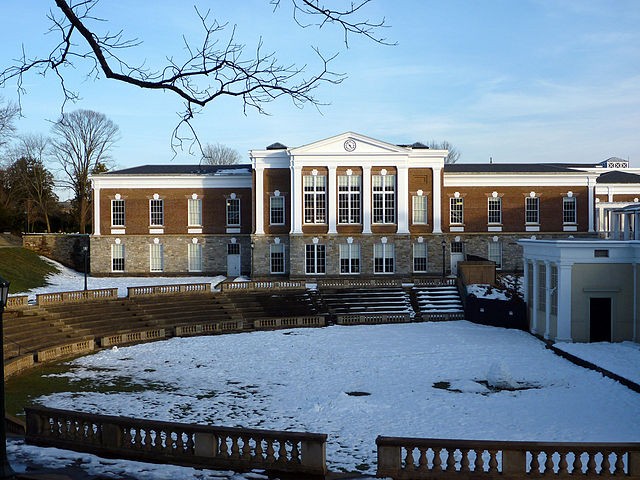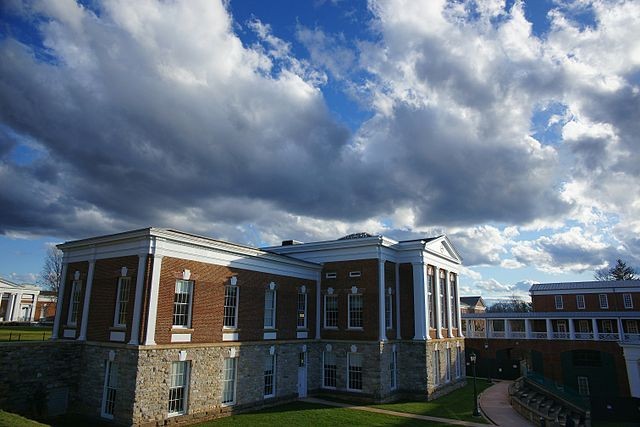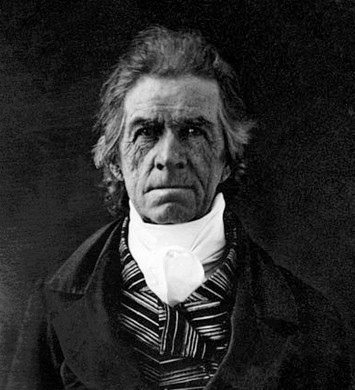Cocke Hall
Introduction
Text-to-speech Audio
Cocke Hall is located on the Lawn of the University of Virginia campus. Designed by Standford White of McKim, Mead & White, this Jefferson Revival building was completed in 1898 as part of an effort to replace classroom space lost in a fire that gutted the Rotunda. Cocke Hall, named after an associate of Thomas Jefferson, originally housed the Mechanical Laboratory. Today, it is used as classroom and office space.
Images
Cocke Hall & Amphitheatre

Cocke Hall, Northeast View

Cocke Hall in 1900

Daguerreotype of John Hartwell Cocke (1780–1866) of Bremo ca. 1850

Backstory and Context
Text-to-speech Audio
Cocke Hall, which sits on the south end of the Lawn at U.Va, flanks Cabell Hall and faces across from Rouss Hall. These structures are designed in a similar fashion to the more elaborate Cabell Hall. The Lawn was the heart of Thomas Jefferson's "Academical Village," the community of students and faculty living and studying within an architecturally unified space.
Cocke Hall is a fine example of Neo-Classical Revival. It was amongst the three buildings designed by the notable architect Stanford White, built to compensate for the loss of the Rotunda Annex. The Rotunda and its extending structure, the Annex, had been destroyed in a devastating fire in 1895. The fire gutted the building and burned most of the contents of the school's library, except for the few books rescued by students. Cocke, Rouss, and Old Cabell Hall were intended to function as academic buildings. Their construction permanently closed off the south end of the Lawn, setting its dimensions permanently and obstructing the view of the Blue Ridge Mountains.
This structure is named for John Hartwell Cocke II, an American military officer, planter, and businessmen. Cocke was also an associate of Jefferson's. He resided at a large plantation mansion at Upper Bremo (now a National Historic District) designed by master builder John Neilson, who had also worked on Monticello. In 1819, Cocke was appointed by Governor James Patton Preston to the first Board of Visitors of the University of Virginia. He retired from the board in 1852.
Though he had inherited a number of slaves, Cocke is known for his hostile attitude toward slavery. He provided educational and training opportunities for slaves in order to prepare them for life as free people and spent his own money to send these freed slaves to the colony in Liberia. His diaries have been the subject of much academic interest, as they reference the relationship between Thomas Jefferson and Sally Hemmings. Cocke did not reveal the details of the relationship until after Jefferson's death.
Cocke Hall is a fine example of Neo-Classical Revival. It was amongst the three buildings designed by the notable architect Stanford White, built to compensate for the loss of the Rotunda Annex. The Rotunda and its extending structure, the Annex, had been destroyed in a devastating fire in 1895. The fire gutted the building and burned most of the contents of the school's library, except for the few books rescued by students. Cocke, Rouss, and Old Cabell Hall were intended to function as academic buildings. Their construction permanently closed off the south end of the Lawn, setting its dimensions permanently and obstructing the view of the Blue Ridge Mountains.
This structure is named for John Hartwell Cocke II, an American military officer, planter, and businessmen. Cocke was also an associate of Jefferson's. He resided at a large plantation mansion at Upper Bremo (now a National Historic District) designed by master builder John Neilson, who had also worked on Monticello. In 1819, Cocke was appointed by Governor James Patton Preston to the first Board of Visitors of the University of Virginia. He retired from the board in 1852.
Though he had inherited a number of slaves, Cocke is known for his hostile attitude toward slavery. He provided educational and training opportunities for slaves in order to prepare them for life as free people and spent his own money to send these freed slaves to the colony in Liberia. His diaries have been the subject of much academic interest, as they reference the relationship between Thomas Jefferson and Sally Hemmings. Cocke did not reveal the details of the relationship until after Jefferson's death.
Sources
"John Hartwell Cocke." Wikipedia, the Free Encyclopedia. Accessed March 19, 2017. http://en.wikipedia.org/wiki/John_Hartwell_Cocke.
"The Lawn." Wikipedia, the Free Encyclopedia. Accessed March 19, 2017. http://en.wikipedia.org/wiki/The_Lawn.
"U.Va. Web Map: Cocke Hall." The University of Virginia. Accessed March 19, 2017. http://www.Virginia.edu/webmap/popPages/23-cockehall.html.
Virginia Historic Landmarks Commission Staff (March 1982). "National Register of Historic Places Inventory/Nomination: Columbia." Virginia Department of Historic Resources. http://www.dhr.Virginia.gov/registers/Cities/Richmond/127-0045_Columbia_1982_Final_Nomination.pdf.
Cocke Hall & Amphitheatre; image by Dana Buntrock" via local louisville - Flickr: Cocke Hall & amphitheater, CC BY 2.0, https://commons.wikimedia.org/w/index.php?curid=12882978.
Cocke Hall, Northeast View; image by Karen Blaha - Flickr: [1], CC BY-SA 2.0, https://commons.wikimedia.org/w/index.php?curid=13275481.
Cocke Hall, Mechanical Laboratory 1900 Special Collections, University of Virginia Library, Charlottesville, Va. http://search.lib.Virginia.edu/catalog/uva-lib:2155033.
"The Lawn." Wikipedia, the Free Encyclopedia. Accessed March 19, 2017. http://en.wikipedia.org/wiki/The_Lawn.
"U.Va. Web Map: Cocke Hall." The University of Virginia. Accessed March 19, 2017. http://www.Virginia.edu/webmap/popPages/23-cockehall.html.
Virginia Historic Landmarks Commission Staff (March 1982). "National Register of Historic Places Inventory/Nomination: Columbia." Virginia Department of Historic Resources. http://www.dhr.Virginia.gov/registers/Cities/Richmond/127-0045_Columbia_1982_Final_Nomination.pdf.
Cocke Hall & Amphitheatre; image by Dana Buntrock" via local louisville - Flickr: Cocke Hall & amphitheater, CC BY 2.0, https://commons.wikimedia.org/w/index.php?curid=12882978.
Cocke Hall, Northeast View; image by Karen Blaha - Flickr: [1], CC BY-SA 2.0, https://commons.wikimedia.org/w/index.php?curid=13275481.
Cocke Hall, Mechanical Laboratory 1900 Special Collections, University of Virginia Library, Charlottesville, Va. http://search.lib.Virginia.edu/catalog/uva-lib:2155033.
